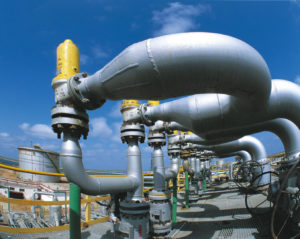Natural gas, a fossil fuel like oil and coal, is the last fossil source of energy to be used on a global scale. It is a mixture of hydrocarbons, mostly methane, and other gaseous substances such as carbon dioxide, nitrogen, hydrogen sulphide and, in some cases, helium, radon and cripton.
 For over a century, when the gas was discovered in areas that were far from the places where it could be utilized, it was preferably burnt at the gas well or freed into the atmosphere, because harnessing it in a pipeline and making it travel for many kilometres was too expensive. With the creation of transport infrastructures for natural gas, the situation has changed over the past forty years and today natural gas ranks third in world consumption of energy and is the fossil source with the best growth prospects.
For over a century, when the gas was discovered in areas that were far from the places where it could be utilized, it was preferably burnt at the gas well or freed into the atmosphere, because harnessing it in a pipeline and making it travel for many kilometres was too expensive. With the creation of transport infrastructures for natural gas, the situation has changed over the past forty years and today natural gas ranks third in world consumption of energy and is the fossil source with the best growth prospects.
From the Seventies up to date world consumption of gas has tripled, growing from 100 billion cubic metres to approximately 3,399 cubic meters in 2011. According to eni, World Oil and Gas Review 2013, Italy produces 8.4 billion cubic metres of natural gas per year and consumes 73 billion cubic metres a year. According to World Oil and Gas Review, in 2006 the availability of natural gas worldwide was about 180,000 billions of cubic meters. If no new fields will be discovered and the current productione will remain costant, this hycarbon will be available for the next 40 years.
Natural gas is normally associated to oil. Before being distributed for use, it is treated to eliminate carbon dioxide and nitrogen, which make it less flammable, and hydrogen sulphide, a corrosive and toxic gas. The result is mainly methane, the simplest gaseous hydrocarbon that is characterised by the smallest molecule. It is lighter than the air ,colourless and odourless and not toxic. It was very common in the primordial atmosphere of the Earth and probably contributed to the synthesis of the first amino acids and the creation of life on our planet.
On our planet hydrocarbons, including methane, are mainly located on rock pores that constitute the higher part of the Earth’s crust and result from chemical and physical processes that have taken place during the history of the Earth. The geographic location of gas reserves mirrors that of oil: Russia, Iran and Qatar approximately have 44% of the total.






